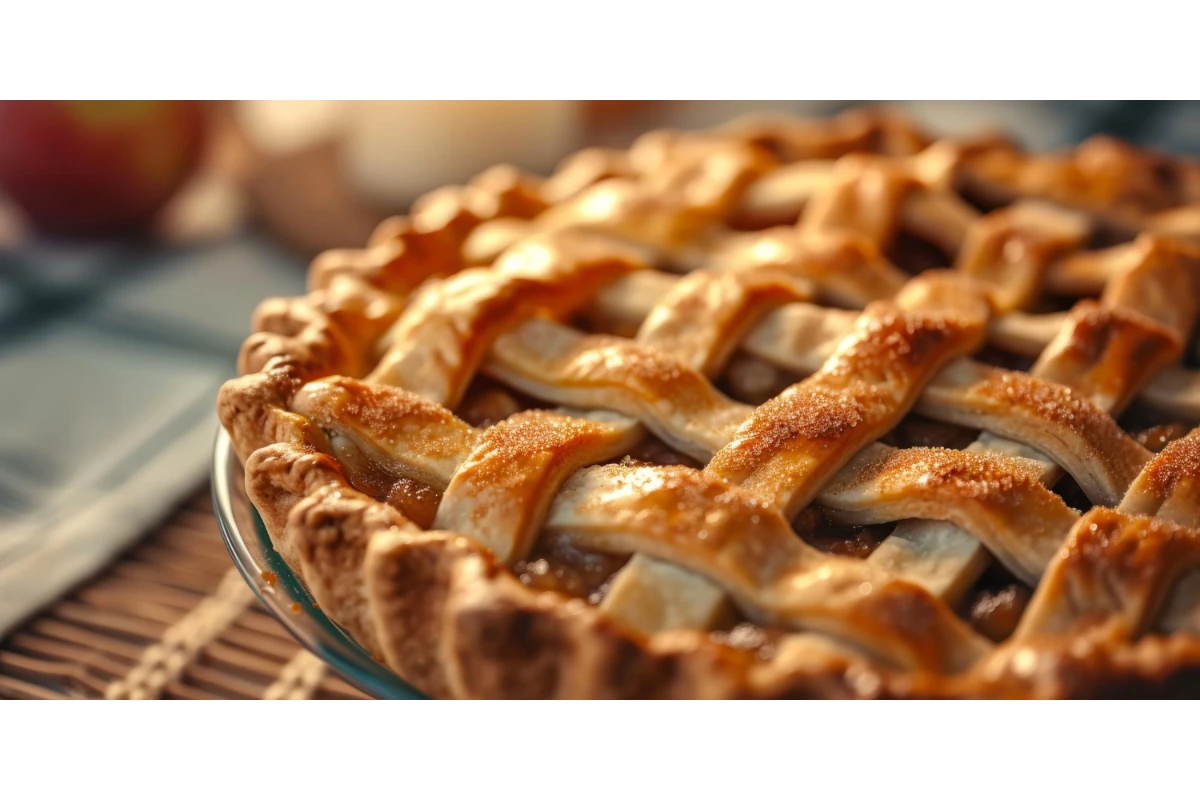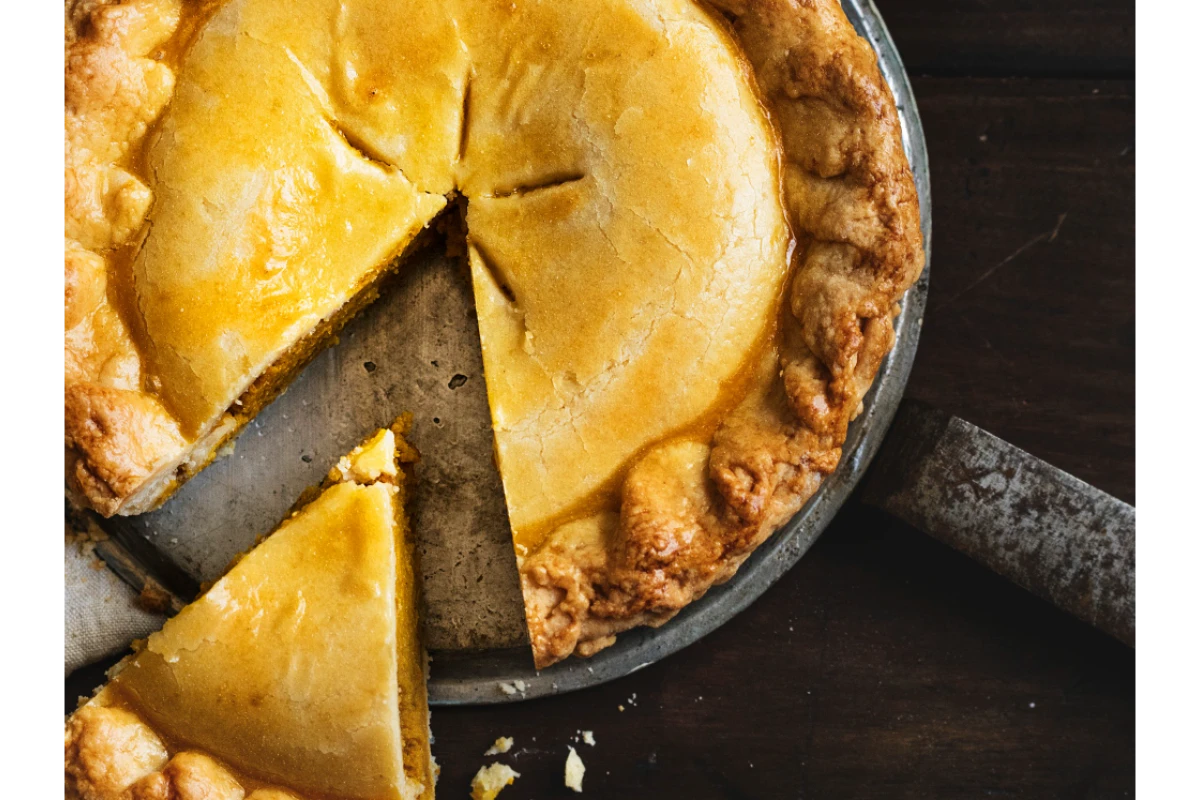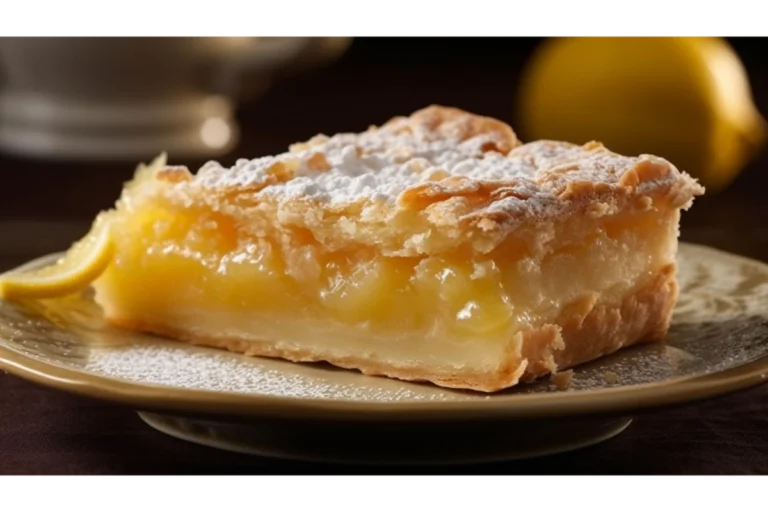Introduction to the Pineapple Pie Article
Embark on a delightful journey with this comprehensive guide to making the perfect Pineapple Pie. Ideal for both novice bakers and seasoned pastry chefs, this article guides you through each step to create a delicious pie. It bursts with the tropical flavors of pineapple. From gathering your ingredients to enjoying the final product, get ready to transform your kitchen into a tropical paradise. Bake a pie that’s as enjoyable to make as it is to eat. Let’s begin this sweet culinary adventure and discover why pineapple pie is more than just a dessert—it’s an experience.
Introduction to Pineapple Pie
Pineapple pie combines the tangy sweetness of pineapple with a buttery, crisp crust. It offers a slice of paradise in every bite. Often overshadowed by apple and cherry pies, pineapple pie deserves recognition for its unique flavor and comforting texture. This part of the article introduces the origins of pineapple pie. It also explains why this delightful treat brings a taste of the tropics to your dining table.
History and Popularity
The journey of the pineapple pie starts in the warm, tropical climates where pineapples thrive. Initially a symbol of hospitality, the pineapple has been celebrated through various culinary delights, but none quite as uniquely comforting as the pineapple pie. It gained popularity in the United States when canned pineapples became widely available, making the exotic fruit more accessible to the average household.
Why Pineapple Pie is a Must-Try
Imagine the scenario: a sunny day, a gentle breeze, and a dessert that perfectly encapsulates summer. That’s what a slice of pineapple pie brings to your plate. It’s not just a dessert; it’s an experience. This pie offers a refreshing twist to dessert time, blending the zest of pineapples with a creamy, lush texture that makes each bite a delightful surprise. Perfect for any occasion, from family gatherings to a quiet summer evening at home, pineapple pie stands out with its vibrant flavor and sunny disposition.
In the next part of our guide, we will delve into the essential ingredients needed to bring this tropical treat to life. Stay tuned to learn how to mix the right components for a perfect pineapple pie that will impress your guests and satisfy your sweet tooth.
This introduction and the first part set the stage for an engaging, informative journey through the art of making pineapple pie. As we continue, each part will build on the last, enriching your understanding and skills in pie-making.

Essential Ingredients
Creating a mouth-watering pineapple pie starts with gathering the right ingredients. Each component plays a crucial role in achieving the perfect balance of flavor and texture. Here, we’ll explore the key ingredients needed for your pie, along with some helpful tips on substitutions and variations to cater to different dietary needs or taste preferences.
List of Ingredients
To embark on your pineapple pie journey, you will need the following items:
- Canned Pineapple: One can of crushed pineapple in juice is ideal for a deep, tropical flavor. Opt for a version with no added sugar to control the sweetness of your pie.
- Sugar: About three-quarters of a cup, adjusted according to your taste preferences. Sugar not only sweetens the pie but also helps thicken the filling.
- Cornstarch: This is used as a thickener to help set the pie filling, ensuring it holds together nicely when sliced.
- Lemon Juice: A splash of lemon juice will not only add a hint of tartness but also enhance the pineapple’s bright flavors.
- Pie Crust: You can use a store-bought crust for convenience, or make your own flaky version at home for a more authentic touch.
- Butter: A small amount of butter adds richness to the filling, balancing the tanginess of the fruit.
Substitutions and Variations
For those who like to tweak recipes to their liking or have specific dietary needs, here are some variations and substitutions:
- Gluten-Free: Replace the regular pie crust with a gluten-free alternative available in most supermarkets, or make your own using gluten-free flour.
- Vegan: Use a vegan pie crust and substitute the butter with a plant-based alternative. Agar-agar can be used instead of cornstarch for a vegan thickener.
- Fresh Pineapple: If you prefer using fresh fruits, you can certainly use fresh chopped pineapple instead of canned. Adjust the sugar since fresh pineapples may be less sweet than their canned counterparts.
- Add-ins: Consider adding other tropical fruits like mango or banana for an extra fruity flavor, or throw in some coconut flakes for a delightful texture and coconutty backdrop.
Understanding and choosing the right ingredients is the foundation of making a great pineapple pie. With these essentials covered, you’re now ready to start preparing your tropical dessert masterpiece. In the next section, we will dive into a step-by-step guide on how to blend these ingredients into the perfect pie.
Stay tuned as we move on to the preparation phase, where we will discuss everything from crafting the perfect crust to achieving the ideal filling consistency for your pineapple pie.
Step-by-Step Guide to Making Pineapple Pie
With your ingredients ready, it’s time to dive into the delightful process of pie-making. This step-by-step guide will walk you through preparing the pineapple filling, crafting the crust, assembling your pie, and finally, baking it to golden perfection. Follow these detailed instructions to ensure your pineapple pie turns out delicious every time.
Preparing the Pineapple Filling
- Combine Ingredients: In a medium saucepan, mix one can of crushed pineapple (with its juice), three-quarters of a cup of sugar, and three tablespoons of cornstarch. Stir these together until the cornstarch is completely dissolved.
- Cook the Mixture: Place the saucepan over medium heat. Keep stirring as the mixture comes to a boil and starts to thicken. This usually takes about 5-7 minutes.
- Add Lemon Juice: Once thickened, add a tablespoon of lemon juice to the mixture. Stir well and allow it to boil for another minute. This not only adds a tangy twist but also helps set the filling.
- Cool Down: Remove the saucepan from the heat and let the filling cool slightly. This will make it easier to handle when assembling the pie.
Making the Crust
- Prepare the Dough: If you’re making homemade crust, combine 2 cups of flour, a teaspoon of salt, and two-thirds of a cup of butter in a large bowl. Utilize a pastry cutter or two forks to combine the butter with the flour until the mixture takes on the texture of coarse crumbs.
- Add Water: Slowly mix in about 4-6 tablespoons of ice water, just enough until the dough comes together.
- Chill the Dough: Wrap the dough in plastic wrap and refrigerate for at least an hour. This helps the fats to firm up, which will give you a flakier crust.
Assembling and Baking the Pie
- Roll Out the Crust: On a lightly floured surface, roll out two portions of pie dough into circles that are larger than your pie dish.
- Line the Pie Dish: Place one dough circle in the bottom of your pie dish. Press it lightly into the dish and trim any excess off the edges.
- Add the Filling: Pour the slightly cooled pineapple filling into the crust-lined pie dish.
- Top It Off: Cover the filling with the second dough circle. Trim any excess dough from the edges and crimp them together to seal the pie.
- Create Steam Vents: Cut a few small slits in the top crust to allow steam to escape during baking.
- Bake: Place the pie in a preheated oven at 425 degrees Fahrenheit and bake for about 35-40 minutes, or until the crust is golden brown.
Cooling and Serving Suggestions
- Cool the Pie: Let the pie cool on a wire rack for at least two hours before serving. This allows the filling to set completely.
- Serve: Serve your pineapple pie slightly warm or at room temperature, perhaps with a scoop of vanilla ice cream or a dollop of whipped cream for an extra indulgent treat.
Following these steps will help you master the art of pineapple pie-making. Each stage from the filling preparation to the baking process is crucial for achieving that perfect tropical dessert that’s sure to impress. Next, we will explore expert tips to ensure every pie you bake turns out just as wonderful.

Expert Tips for the Perfect Pineapple Pie
Crafting the ultimate Pineapple Pie Recipe is about more than just following steps. It involves mastering nuances that make your pie stand out. Here are some expert tips to help you create a pineapple pie that’s as delightful to look at as it is to eat. Whether you’re striving for a flaky crust or a perfectly balanced filling, these tips will enhance your baking prowess.
Achieving a Flaky Crust
The crust is arguably as important as the filling in any pie recipe, especially in a Pineapple Pie Recipe. Here’s how to ensure your crust is flaky and delicious:
- Chill Your Fats: The key to flakiness lies in the fats (butter or shortening) staying solid until they hit the oven. Keep your butter and even your mixing bowl chilled until you’re ready to use them.
- Minimal Handling: Overworking the dough activates the gluten in the flour, which can make the crust tough. Mix just until the dough comes together to maintain tenderness.
- Blind Baking: Consider partially baking your crust before adding the filling. This method helps prevent the crust from becoming soggy and maintains its structural integrity.
Balancing Sweetness and Texture in the Filling
The Pineapple Pie Recipe filling should sing with the bright, sweet notes of pineapple, balanced by the right texture:
- Adjust Sugar According to Pineapple Sweetness: Since the natural sweetness of pineapple can vary, adjust the sugar levels based on your taste and the sweetness of the fruit.
- Right Thickening Agent: Cornstarch is excellent for thickening the juicy filling, but be sure to cook it long enough during the filling preparation stage to avoid a starchy flavor.
Storing Your Pineapple Pie
Here’s how to keep your pineapple pie tasting fresh, whether you’re enjoying it the next day or next month:
- Cooling Before Storage: Let the pie cool completely at room temperature to avoid condensation and a soggy crust when covered.
- Refrigeration: For short-term storage, cover the pie loosely with foil or plastic wrap and refrigerate. will maintain its freshness for approximately 3 to 4 days.
- Freezing Tips: For longer storage, wrap the pie tightly in several layers of plastic wrap and then in foil. Freeze the pie to extend its life for up to two months, ensuring it retains its texture and flavor when reheated.
With these expert tips, your Pineapple Pie Recipe will not only be a joy to make but also a hit with anyone who tries it. These strategies are designed to enhance every aspect of the pie, from crust to filling, ensuring delicious results every time. In the next part, we’ll look at the nutritional benefits of incorporating pineapple into your desserts, adding yet another reason to love this tropical pie.
Nutritional Information for Pineapple Pie
Understanding the nutritional aspects of your Pineapple Pie Recipe can enhance your appreciation of this delightful dessert. Pineapples bring a wealth of health benefits to the table, making this pie not just a treat for the taste buds but also a boon for your health. Here’s a breakdown of the nutritional content and benefits of including pineapple in your recipes.
Caloric Content
The caloric value of a pineapple pie can vary based on the ingredients. These include the type of crust, amount of sugar, and any substitutions like low-fat butter or sugar alternatives. Typically, a standard slice of pineapple pie contains approximately 300 to 400 calories. For those monitoring their calorie intake, adjusting the ingredients to suit dietary needs can help manage this aspect.
Nutritional Benefits of Pineapple
Pineapple is not just delicious; it’s also packed with nutrients that offer several health benefits:
- Vitamin C: One of the strongest reasons to indulge in a Pineapple Pie Recipe is the high vitamin C content of pineapple. This essential vitamin is a powerful antioxidant that helps protect the body against free radicals and supports the immune system.
- Manganese: Pineapples are a good source of manganese, a mineral that is essential for developing strong bones and connective tissue.
- Dietary Fiber: While the pie crust may offer some fiber, the pineapple filling boosts the fiber content, which aids in digestion and maintains good gastrointestinal health.
- Bromelain: This enzyme, found in pineapples, has anti-inflammatory properties, aids digestion, and may help reduce the risk of chronic diseases such as heart disease.
For those looking to delve deeper into the numerous health benefits of pineapple, such as its vitamin content and enzymes that aid digestion, this comprehensive guide on the health benefits of pineapple offers valuable insights.
Considerations for a Healthier Pie
For those looking to enjoy a pineapple pie while keeping an eye on nutrition, here are a few tips:
- Reduce Sugar: Consider reducing the sugar added to the filling or using natural sweeteners like honey or agave syrup to lower the glycemic index.
- Whole Wheat Crust: Opt for a whole wheat pie crust to increase the fiber content and add a nuttier, richer flavor to your pie.
- Add Other Fruits: Incorporating other fruits like berries or citrus segments can enhance the nutritional profile and add new flavors to your Pineapple Pie Recipe.
By being mindful of these nutritional details, you can make informed choices about how to prepare and enjoy your Pineapple Pie Recipe. Not only will you satisfy your sweet tooth, but you’ll also reap the health benefits that pineapples bring. In the next part of our guide, we’ll address frequently asked questions about making pineapple pie. This will ensure you have the knowledge to bake with confidence.
Frequently Asked Questions
Navigating through the nuances of baking a Pineapple Pie Recipe can bring up a variety of questions. This FAQ section is designed to clarify your queries and ensure that every aspect of your pie-making experience is smooth and enjoyable. Here are some of the common questions and detailed answers to help you perfect your pineapple pie.
What is Johnny Cash Pie?
Johnny Cash pie, often referred to as Million Dollar Pie, is a no-bake dessert that’s simple yet rich in flavor. It’s named after the famous singer due to its popularity and “rich” taste. The pie typically includes crushed pineapple, pecans, sweetened condensed milk, and lemon juice, which are mixed together, poured into a graham cracker crust, and chilled until set. It’s a quick and easy dessert option that’s perfect for gatherings.
What is a Million Dollar Pie Made Of?
Million Dollar Pie, also known as Johnny Cash Pie, is made from key ingredients. These components give it a distinctive, luxurious taste. The recipe usually includes sweetened condensed milk and lemon juice to set the filling. It also features crushed pineapple and chopped pecans. Sometimes, maraschino cherries and coconut are added for extra texture and flavor. This mixture is poured into a graham cracker crust and chilled, resulting in a creamy, refreshing pie.
Can I Use Fresh Pineapple Instead of Canned in Pineapple Pie?
Yes, fresh pineapple can definitely be used in your Pineapple Pie Recipe as a substitute for canned. When using fresh pineapple, ensure it is ripe to optimize the sweetness and flavor. Using fresh pineapple may require slight adjustments in sugar and thickener. This accounts for its higher moisture content compared to canned pineapple.
The caloric content of a slice of pineapple pie can vary based on the ingredients and preparation methods used. Typically, a slice of pineapple pie can range from 300 to 450 calories. Factors such as the type of crust, the amount of sugar, and additional fillings like nuts or toppings can influence the calorie count. For those conscious about calorie intake, consider lighter substitutions. Use a low-fat crust or sugar alternatives to reduce the overall calorie content.
These FAQs address key questions about making and enjoying pineapple pie. They cover topics from variations like the Million Dollar Pie to dietary adjustments needed for the traditional recipe. With these insights, you’re well-equipped to bake a pie that not only tastes great but also caters to your specific needs and curiosities.

